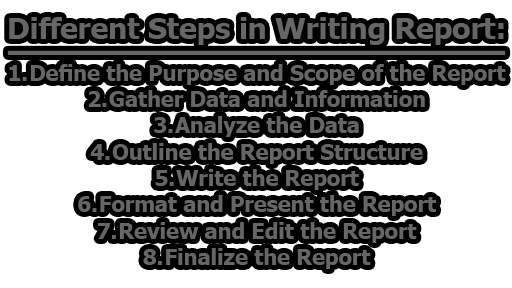Report writing is a structured method of documenting and presenting information in a clear and concise manner. Reports are used for various purposes, including presenting research findings, providing information about a particular topic, or summarizing data and statistics. In this article, we are going to know about the different steps in writing a report, the types of report writing, and the layout of the research report.
Different Steps in Writing Report:
Writing a report can be a complex and time-consuming process, but by following a structured approach, you can ensure that your report is clear, concise, and effective. Here are the steps involved in writing a report:
- Define the Purpose and Scope of the Report: Determine the reason for writing the report and what you want to achieve with it. This will help you to focus your research and determine what information to include in the report.
- Gather Data and Information: Collect relevant data and information from various sources, such as books, articles, interviews, and surveys. Ensure that the information you gather is accurate and relevant to the purpose of the report.
- Analyze the Data: Organize and analyze the data to identify trends, patterns, and relationships. This will help you to draw meaningful conclusions and make recommendations.
- Outline the Report Structure: Create an outline of the report’s structure, including the main sections, sub-sections, and headings. This will help you to organize the information and ensure that the report is easy to read and understand.
- Write the Report: Start by writing the introduction, which should provide background information and explain the purpose of the report. Then, write the main body of the report, including the results, discussion, and conclusion. Finally, write the executive summary and conclusion, which should summarize the main findings and recommendations of the report.
- Format and Present the Report: Format the report to ensure that it is visually appealing and easy to read. Choose appropriate charts, tables, and graphs to present the data and make sure they are easy to understand.
- Review and Edit the Report: Review the report for grammar, spelling, and punctuation errors. Ensure that the report is well-structured and that the information is presented in a clear and concise manner. Make revisions as needed to improve the overall quality of the report.
- Finalize the Report: After you have reviewed and edited the report, it’s time to finalize it. This can include adding a title page, table of contents, references, and appendices, if necessary.
By following these steps, you can write a report that effectively communicates your findings and provides valuable insights to your audience.
Types of Report Writing:
There are various types of report writing, each with its own unique purpose and format. Some of the most common types of reports include:
i. Business Reports: These reports provide information and analysis to support decision-making in a business setting. They may include financial reports, marketing reports, operational reports, and strategic reports.
ii. Academic Reports: Academic reports are written for educational purposes and often take the form of research reports, lab reports, or case studies. They are used to present the results of academic research and provide a detailed analysis of the findings.
iii. Technical Reports: Technical reports are written to document the results of scientific or engineering research. They often include detailed descriptions of methods, procedures, and results, as well as graphs, diagrams, and other visual aids.
iv. Feasibility Reports: Feasibility reports are written to assess the viability of a proposed project or initiative. They include an analysis of the costs, benefits, and risks associated with the project, as well as a recommendation as to whether or not it should be pursued.
v. Progress Reports: Progress reports are written to provide updates on the progress of a project or initiative. They are often used to communicate the status of the project to stakeholders and provide information on any challenges or obstacles that have been encountered.
vi. Incident Reports: Incident reports are written to document events or incidents that have taken place, such as accidents, security breaches, or equipment failures. They are used to record what happened, why it happened, and what steps were taken to address the issue.
vii. Analytical Reports: Analytical reports are written to provide a comprehensive analysis of a particular issue or topic. They may include an analysis of data, trends, and patterns, as well as recommendations for future action.
The type of report you write will depend on the purpose of the report. It’s important to choose the right format and style to ensure that the report is effective in communicating its message.
The layout of the Research Report:
The layout of a research report is an important aspect of the overall report as it affects readability, clarity, and the impact of the report on its intended audience. Here is a typical layout of a research report:
- Title page: The title page should include the title of the report, the author’s name, the date of submission, and the name of the organization or institution.
- Abstract: The abstract is a brief summary of the report, including its purpose, methodology, results, and conclusions. It should be concise and not exceed 200-300 words.
- Table of Contents: This section lists the major sections of the report and their corresponding page numbers.
- Introduction: The introduction should provide background information on the topic of the research, explain the purpose of the study, and describe the research questions or hypotheses being investigated.
- Literature Review: This section reviews previous studies and research on the topic and provides a context for the current research.
- Methodology: The methodology section should describe the research design, sampling method, data collection techniques, and data analysis methods used in the study.
- Results: The results section presents the findings of the study, including any data collected, tables, graphs, or charts.
- Discussion: The discussion section provides an interpretation of the results, draws conclusions, and discusses the implications of the findings.
- Conclusion: The conclusion should summarize the main findings of the study and their implications, and provide recommendations for future research.
- References: The references section lists all the sources cited in the report, including books, articles, and other sources of information. The references should be formatted according to the appropriate citation style (e.g., APA, MLA, or Chicago).
- Appendices: The appendices section includes any additional material that supports the information in the report, such as raw data, questionnaires, or interview transcripts.
It’s significant to keep in mind that the layout of a research report may vary depending on the specific guidelines provided by your instructor or the academic institution. However, the above layout is a standard structure for most research reports.

Assistant Teacher at Zinzira Pir Mohammad Pilot School and College










